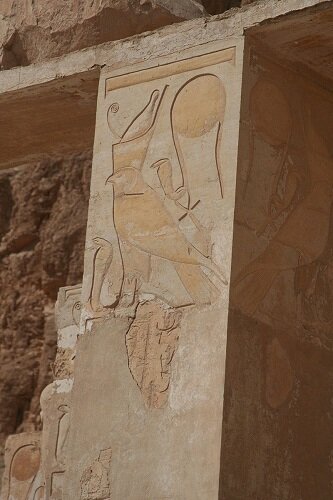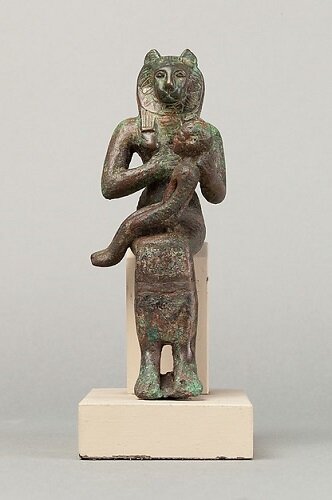The Sunday Section: Ancient Egypt - The Story of Sekhmet
I was going to finish the ‘Ancient Egypt’ section last week, but, having listed the deities, I wanted to share more of their stories, like that of Isis and Osiris. But I’ll start with one of my favourites, Sekhmet, the lion-headed goddess, one of the oldest known Egyptian deities.
Sekhmet - Medinet Habut temple, west bank of the Nile at Luxor
Before the unification of the land, Upper and Lower Egypt had different patrons and protectors – Sekhmet was the warrior goddess for Upper Egypt, and Wadjet was the patron and protector of Lower Egypt.
Wadjet was also the protector of kings, and of women in childbirth. Her name is linked to the symbol of Lower Egypt, the papyrus, and means ‘papyrus-coloured one’; wadj being the word for ‘green’ (the colour of the papyrus plant), and et, an indication of her gender. Associated with the land, she was depicted either as a snake-headed woman, or the Egyptian cobra.
Wadjet wearing the red crown of Lower Egypt
(Image was on flickr but the stream is no longer available)
The image of the uraeus with the sun disk represents Wadjet, and was the emblem of the crown of the rulers of Lower Egypt.
Wadjet as uraeus and cobra - The Hawk of Pharaoh, Hatshepsut’s Temple, Luxor (Steve FE Cameron)
Wadjet is shown as a uraeus sun disk with her head through an ankh, and also as a cobra preceding the Horus hawk wearing the double crown of the united Egypt
She was also closely associated with the Eye of Ra, a powerful protective deity. Her symbol as protector is the Wadjet Eye, which is also known as the Eye of Horus.
Wadjet Eye
Her link with Horus is possibly due to the belief that she helped Isis nurse the infant Horus, and helped hide him from Set and his followers.
Wadjet with the Horus-child (Metropolitan Museum)
Wadjet was later linked with Bast, the war goddess of Lower Egypt, and, in that form, was known as Wadjet-Bast. As Bast was a lioness, Wadjet-Bast was depicted with a lioness head.
Wadjet-Bast (Louvre Museum)
When Upper Egypt conquered Lower Egypt, and they were unified, the lioness goddess of Upper Egypt, Sekhmet, was seen as the more powerful. As often happens, Wadjet-Bast was merged with Sekhmet. Despite this assimilation, the symbols of Wadjet are still visible in the form of her solar disc and uraeus.
Painted carving of Sekhmet, Medinet Habu temple, west bank of the Nile at Luxor
A solar deity, Sekhmet is thought to be the daughter of Ra, and is usually associated with Hathor and Bast. Apart from the solar disc and uraeus, another of Sekhmet’s symbols is the ankh. She was not only the warrior goddess of Upper Egypt, she was also the goddess of healing. Known as a terrifying goddess, and one who could cure disease, she was called, both, the ‘lady of terror’, and the ‘lady of life’.
Sekhmet at Medinet Habu, mortuary temple of Usimare Ramesses III
Sekhmet’s name comes from the Ancient Egyptian word, sekhem, which means ‘power’ or ‘might’. Her name is usually translated as the ‘Powerful One’, or ‘She Who is Powerful’. Her other titles include, ‘She Before Whom Evil Trembles’; ‘Mistress of Dread’; ‘Lady of Slaughter’; and ‘She Who Mauls’. Also known as the ‘Lady of Pestilence’, it was believed that she could send plagues against those who angered her.
Sekhmet (Glencairn Museum)
As the protector of Ma’at – balance or justice – another of Sekhmet’s names is ‘The One Who Loves Ma’at and Who Detests Evil’. The story goes that humanity had grown negligent in observing Ra’s laws, and was no longer preserving ma’at. Angered, Ra decided to punish them. He plucked Hathor from his brow, and sent this Eye of Ra to teach mankind a lesson. Taking the form of a lioness, she became Sekhmet, and rampaged through the land, staining it red with the blood of the people. Not a vengeful god, Ra grew distressed at the people’s suffering, and ordered Sekhmet to stop. But she could not hear him, so consumed was she with bloodlust. Ra then ordered thousands of jugs of beer stained red with pomegranate juice to be readied, and he poured them in her path. Believing it to be more blood, Sekhmet consumed it all. The beer had the desired effect; drunk with the beer, she fell asleep, and slept for 3 days. On awakening, her bloodlust had dissipated, and mankind was saved.
Necklace from 19-20 Dynasty









